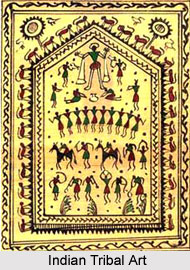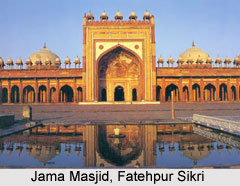 Influences on Indian art took place since time immemorial and at various levels like religious, social and cultural. India being a country which has witnessed an assimilation of different races, religions, culture and languages at various points of times, thus a diverse nature of art forms, paintings, architecture, and folk traditions are noticeably evident. The journey of an Indian artist is an inevitable procession from archaic to Renaissance to Baroque, or from linear to plastic to pictorial expressions.
Influences on Indian art took place since time immemorial and at various levels like religious, social and cultural. India being a country which has witnessed an assimilation of different races, religions, culture and languages at various points of times, thus a diverse nature of art forms, paintings, architecture, and folk traditions are noticeably evident. The journey of an Indian artist is an inevitable procession from archaic to Renaissance to Baroque, or from linear to plastic to pictorial expressions.
Influence of different religions like Hinduism, Buddhism, Islam and Christianity is profoundly evident in Indian art. Buddhism is one of the ancient religions to bestow its influence on Indian art as seen in the stupas and chaityas. The temple architecture of the Chola and Chera dynasty and the Rajasthani School of Painting of the Rajput period reflect the influence of Hinduism. India has always been the abode of multiple religions and cultures and thus it has as well experienced the impact of Islam during the Mughals. Christianity also has a significant role in the moulding of Indian art.
 Indian art is significantly influenced by the various invasions that took place in the history of India. The first invaders were the Aryans in northern India after they demolished the Indus valley civilisation. They imposed their social and philosophical ideas on India and the art forms of India became a mixture of Aryan and Dravidian cultures. The Mughal influence was another significant milestone in the evolution of Indian art forms. They were an imperial power and induced considerable indo-Islamic-Persian influence on the various styles of Indian art. The Taj Mahal and the city of Fatehpur Sikri are the magnificent examples of the Mughal architecture. Finally it is the British invasion that affected Indian art form. It was marked by construction of colossal stone and wooden structures in the 17th century.
Indian art is significantly influenced by the various invasions that took place in the history of India. The first invaders were the Aryans in northern India after they demolished the Indus valley civilisation. They imposed their social and philosophical ideas on India and the art forms of India became a mixture of Aryan and Dravidian cultures. The Mughal influence was another significant milestone in the evolution of Indian art forms. They were an imperial power and induced considerable indo-Islamic-Persian influence on the various styles of Indian art. The Taj Mahal and the city of Fatehpur Sikri are the magnificent examples of the Mughal architecture. Finally it is the British invasion that affected Indian art form. It was marked by construction of colossal stone and wooden structures in the 17th century.
Society too had contributed in shaping art in India. However, social influence is comparatively a recent phenomenon. Primarily the influence on Indian art has been religious. It depended on the various kingdoms that came into being at different times. The rulers of the empires that dominated India moulded the art forms according to their taste and preference. But later during the independence struggle, there was a social upheaval and it was then that the various art forms depicted the society in real sense of terms in order to infuse the spirit of patriotism among the citizens.
Besides these factors, Indian tribal art plays a significant role in influencing modern art. The tradition of painting in the cave shelters or against mottled rocks with black or earth colours have revived in the 20th century due to western influence as wall paintings with pastel colours.
Thus, it is to be noted that religion, foreign invasions, change in society and folk traditions have influenced Indian art at various point of time and altogether contributed in the evolution of Indian art.



















